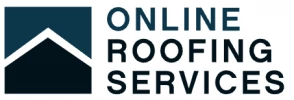Late updated: 24 Oct 2025 13:10
Written by: Oliver Bennett
Innovative Roof Safety Devices For UK Homes: Enhancing Home Protection
In recent years, the importance of roof safety in residential settings has gained much attention, especially here in the UK, where a diverse range of weather conditions can impact the integrity of homes. Innovative roof safety devices are critical not only for protecting us from the elements but also for ensuring the safety of individuals who perform maintenance tasks on our roofs. As technology continues to advance, these devices have become more sophisticated, offering solutions that are both efficient and sustainable. From smart roofing gadgets that boost energy efficiency to robust guardrail systems providing fall protection, the options are expansive and ever-growing.
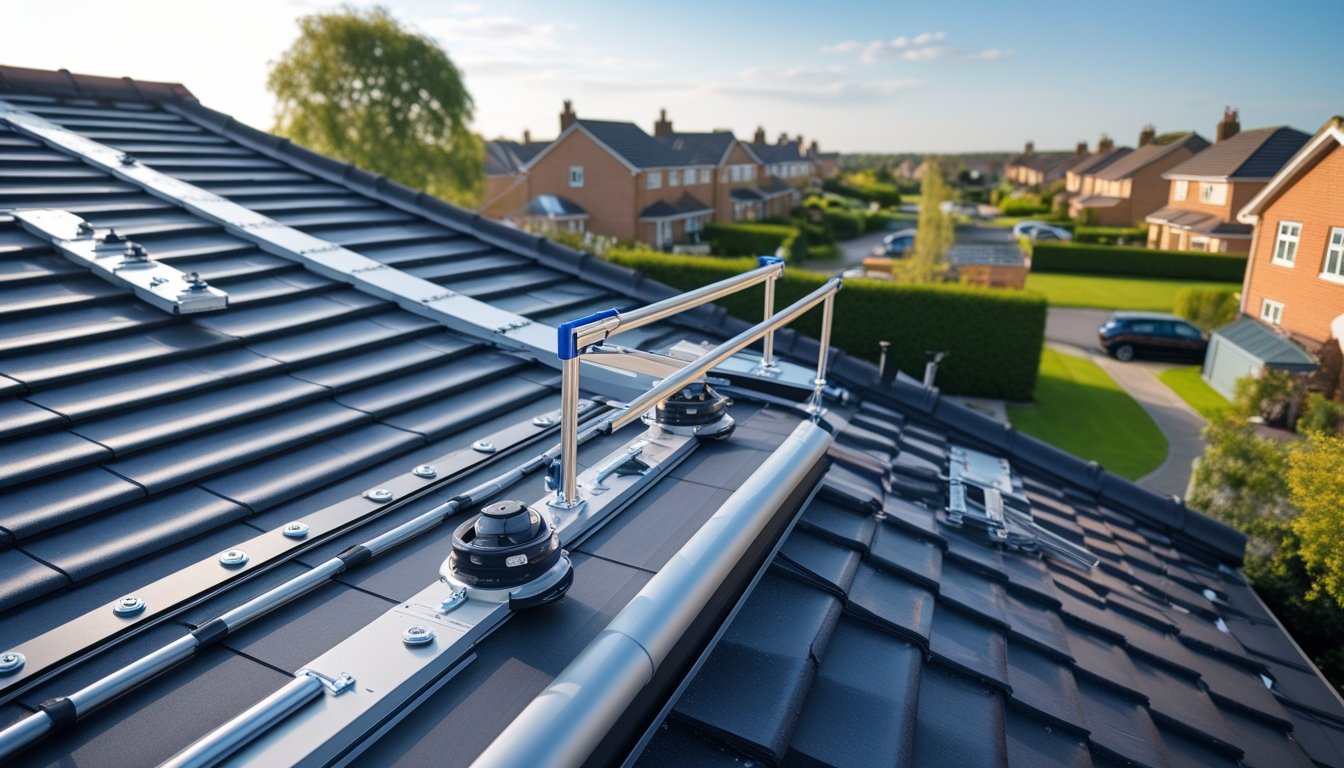
As homeowners, it's essential to stay informed about the most recent advancements in roof safety. Doing so not only safeguards our families but also prolongs the lifespan of our homes. New systems such as modular access platforms are transforming how we approach roof maintenance, making it safer and simpler. With proper knowledge and the right tools, we can significantly reduce the risks associated with working at height, offering peace of mind and enhanced security for all who access our roofs.
Key Takeaways
- Innovative devices enhance roof safety and efficiency.
- Proper knowledge and tools can reduce work-at-height risks.
- New technology offers robust safety solutions for UK homes.
Key Roof Safety Devices for UK Homes
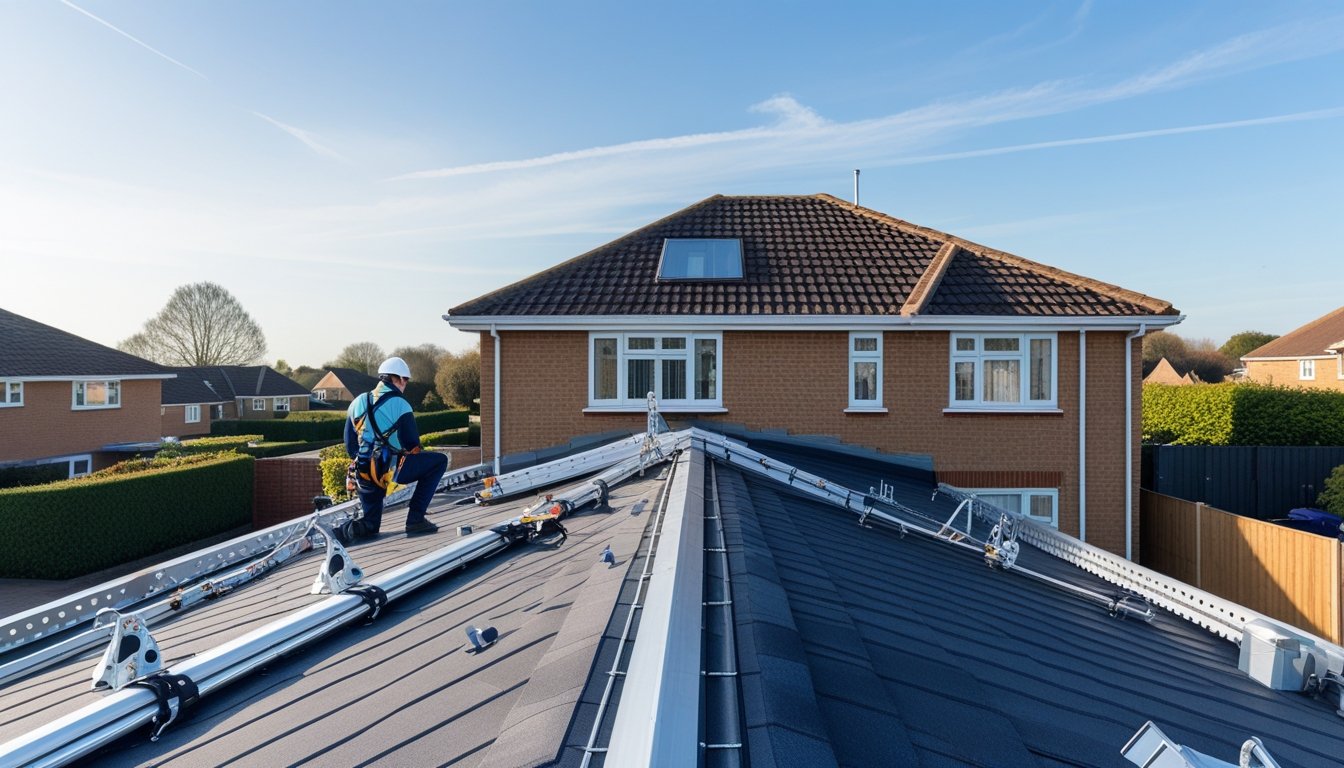
In the UK, ensuring safe roof maintenance and access involves a blend of collective and personal safety systems. Efficient roof safety devices not only prevent falls but also offer durable and practical solutions for accessing roofs.
Collective Fall Protection Systems
Collective protection systems play a crucial role in maintaining roof safety. Guardrails, which are often modular and free-standing, provide a reliable barrier at the roof edge. These systems protect multiple workers simultaneously without the need for personal gear.
Another significant feature in this category is edge protection, designed to prevent falls from flat or sloped roofs. These setups, including non-penetrative guardrails, ensure that the roof membrane remains intact. Advanced systems like the Kee Guard offer versatility, with the option to provide temporary or permanent solutions depending on the project's requirements. Their ease of installation and compliance with UK safety regulations make them essential for safeguarding our rooftops.
Personal Fall Protection Equipment and Systems
Personal fall protection equipment (PPE) is vital for those working at heights. This includes harnesses, lanyards, and horizontal lifelines. Such systems are designed for individual protection and are crucial when collective measures are insufficient or impractical.
A well-designed fall protection system uses lifelines and harnesses to ensure worker safety during roof activities. Horizontal lifeline systems allow mobility while providing a secure anchoring point, minimizing the risk of falls. Selecting the right PPE requires understanding different systems and ensuring their compatibility with existing safety protocols. Our equipment must meet stringent safety standards to protect workers on various kinds of roofs.
Innovative Roof Access Solutions
Accessing the roof safely is often a challenge; innovative solutions are required to make this process secure. Systems such as portable ladders and scaffoldings, when used correctly, enhance roof access safety.
In particular, systems that integrate with existing structures, like modular walkways or staircases, offer safer pathways for individuals to navigate rooftops without compromising on safety. The integration of these solutions with roof-mounted devices ensures that the overall safety system is robust, adhering to both efficiency and safety. These access solutions are designed to minimize accidents and facilitate maintenance tasks in residential and commercial properties alike.
Installation, Maintenance, and Compliance Considerations
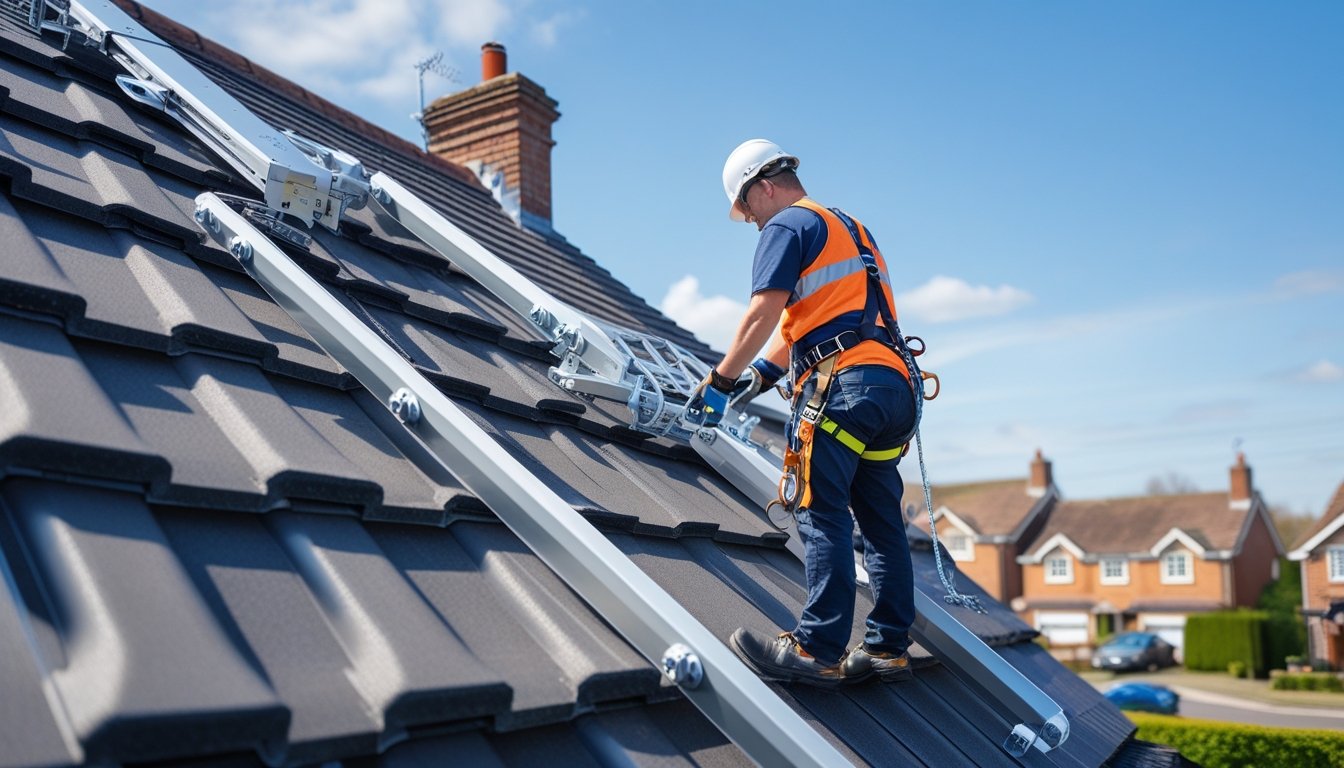
Ensuring the safety and compliance of roof installations involves understanding local regulations, adhering to best installation practices, and maintaining the installed systems. This balance of legal and practical aspects is crucial for optimal performance and safety.
Legal Obligations and UK Safety Standards
Navigating the legal landscape of roof safety involves understanding the UK's health and safety regulations related to working at height. We need to comply with the Work at Height Regulations 2005, which mandate safety measures to prevent falls. Using certified roof anchors and edge protection systems is imperative for compliance.
Regularly updating our knowledge about safety laws helps us maintain compliance and safeguard our workers. Adhering to these standards not only protects property and people but also ensures that any inspections or audits go smoothly. Failure to comply can result in legal liabilities, fines, or even accidents.
Installation Best Practices
For effective installation, selecting the right materials and systems is fundamental. Non-penetrating edge protection is increasingly popular as it mitigates potential damage to the roof itself. When installing roof anchors or anchor systems, it's critical to ensure they're positioned to prevent trip hazards and allow ease of movement.
A thorough plan and precise positioning of safety equipment contribute to effective fall protection. Ensuring that installers are trained and competent is equally important to prevent errors during the setup process. Quality assurance steps like double-checking anchor points and edge protection fixtures ensure the installation meets safety and durability requirements.
Routine Inspections, Maintenance, and Recertification
Once installed, routine inspections are vital to identify any wear or damage in the safety systems. Regular maintenance is required to uphold the safety standards and ensure the systems remain effective over time. Systems like freestanding roof edge protection should be inspected regularly to guarantee they meet safety standards.
Periodic recertification is necessary to confirm that the installations continue to comply with current safety regulations. Keeping detailed records of inspections and maintenance activities not only helps in ensuring compliance but also in identifying potential improvements. Having a maintenance schedule that includes visual checks, system tests, and recertification helps in maintaining high safety standards.
Frequently Asked Questions
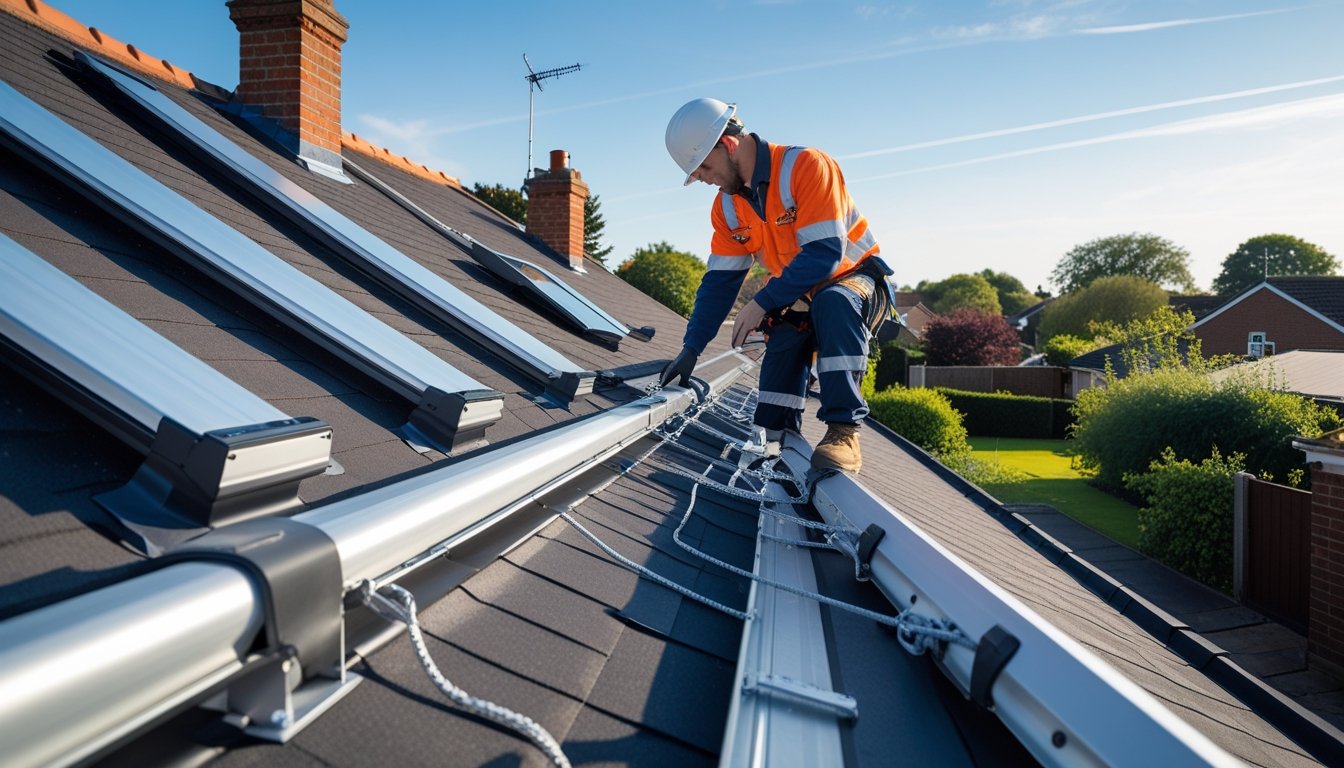
Advancements in roof safety devices are making UK homes safer while blending these systems with aesthetics has become increasingly feasible. Features like guardrails, weather considerations, and strategic anchor points ensure both safety and visual appeal.
What are the latest advancements in residential roof safety equipment?
With technology evolving, roof safety equipment now includes integrated monitoring systems and smart gadgets. Solar roof tiles are gaining popularity, providing both energy efficiency and safety features. These innovations enhance security and reduce the risk of accidents.
How do guardrail systems enhance safety for UK home roof maintenance?
Guardrail systems provide essential protection by preventing falls during maintenance. They are constructed to withstand harsh weather, ensuring durability. For UK homes, these systems offer peace of mind during routine checks or repairs, making maintenance tasks safer and more efficient.
What features should be considered when choosing a roof anchor point for domestic use?
Selecting the right roof anchor point is crucial for safety. Key considerations include the material’s strength and weather resistance. Anchor points should comply with UK safety regulations and be suitable for different roof types, such as pitched or flat roofs, ensuring secure attachment during maintenance work.
How does the UK weather influence the selection of roof safety devices for homes?
The UK weather, known for its unpredictability, influences the choice of roof safety devices. It’s essential to consider systems that can withstand heavy rain and high winds. Devices that are corrosion-resistant and robust ensure long-term functionality, maintaining household safety year-round.
What are the best practices for installing and maintaining roof safety systems in the UK?
Proper installation by certified professionals is paramount to ensure system effectiveness. Regular maintenance checks are advised to identify and resolve potential issues promptly. Engaging with safety regulations and staying informed about updates can help in maintaining both compliance and safety standards.
Can roof safety devices be aesthetically integrated into British home designs?
Yes, roof safety devices can be integrated into home designs without compromising aesthetics. Options like foldable guardrails and low-profile anchor systems allow for safety features that do not detract from a home’s visual appeal. Thoughtful design ensures harmony between safety and aesthetics.
